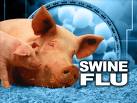
| Swine Flu, H1N1 or the 2009 Influenza A Virus—no matter what you call this flu, you do not want to catch it this year. Since October 2008, the Center for According to the CDC, the spreading of the 2009 H1N1 virus occurs in the same way that the seasonal flu spreads. Flu viruses are mostly spread through by coughing or sneezing in public. Occasionaly, some may even become infected by touching something, like an object or surface, containing flu viruses on it, and then touching their own nose or mouth. The main steps that should be taken to prevent the flu, whether seasonal or the H1N1, include covering your mouth when sneezing or coughing, washing your hands, and eating a healthy diet. Health professionals have been trained to cough into their sleeves. This is a wonderful, health promoting practice more people should try to embrace. Everyone could stand to be a little more considerate and careful when they sneeze or cough in public. Simply turning your head to the side and coughing over your shoulder is not good enough to stop the spread of germs. Because the 2009 H1N1 and most other flu viruses are contagious, we should take every possible effort to decrease the germs we spread. The CDC has suggested two ways to cover our coughs and help fight the spread of germs. First of all, make an effort to cover your cough and mouth with a tissue, then immediately throw the tissue away. If you cannot grab a tissue or paper towel quick enough, cough into the sleeve of your upper arm. The CDC recommends not coughing or sneezing into your hands. This makes perfect sense because when you sneeze into your hands, for example, you just spread all of those germs all over the most used part of your body, thus potentially spreading even more germs than sneezing into the air would have done. When it comes to keeping your hands clean, it is extremely vital to wash them regularly, especially after sneezing, coughing or using the restroom. A satisfactory washing of the hands consists of washing one’s hands for at least 20 seconds under warm water with soap. The water needs to be warm to the touch, but not hot enough that it burns or is uncomfortable. The heat of the water helps fight off germs. The use of soap and a tough scrub on the hands for 20 seconds further helps to kill bacteria. Try to scrub between the knuckles and under fingernail tips. A good way to make sure you are washing your hands for a long enough period of time is to sing a short nursery song, like the ABC’s. Children’s songs usually last about 20 seconds and make for a fun way to time yourself. Making healthy food choices is another fantastic way to avoid the flu. There are many ways you could boost your immune system and help keep the flu away. Eating alkalinizing foods is a great immune booster because they are anti-inflammatory. Anti-oxidant rich foods, like fruits and vegetables, are excellent in preventing chronic inflammation. If you want to make your diet more alkaline rich, try to eat more lean meats, vegetables, fruits and whole grains. Adding green tea, cold pressed olive oil and drinking lots of water to flush out harmful toxins are also recommendations for fighting off the flu. Obviously, preventing the flu is much easier than treating it. So, be careful and limit unneccessary contact with potentially germ covered surfaces. Cough into tissues, wash your hands and eat powerful anit-oxidant containg foods. While these remedies may seem obvious, sometimes they are east to forgetl. It is especially important to make healthy choices during flu-season, particulary with the threatenings of the H1N1 again. Be sure to take your protective measures today, tomorrow and every day. By C.S. Lewis |










